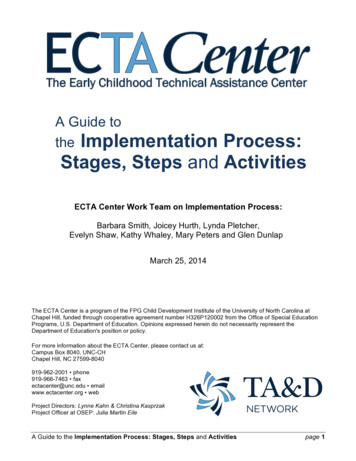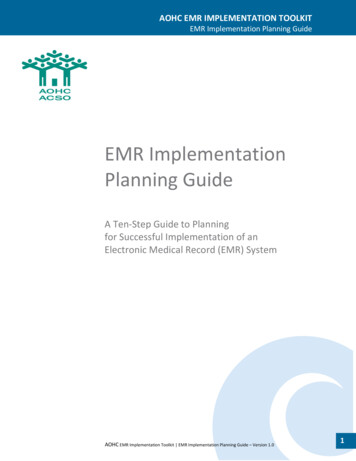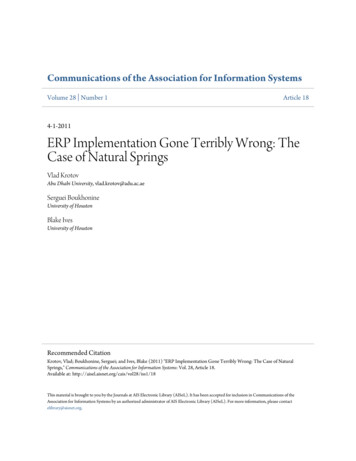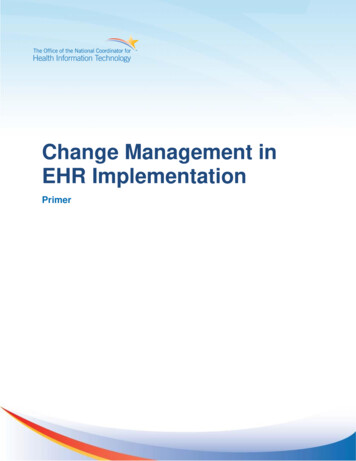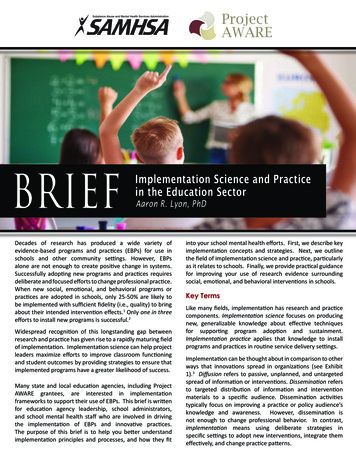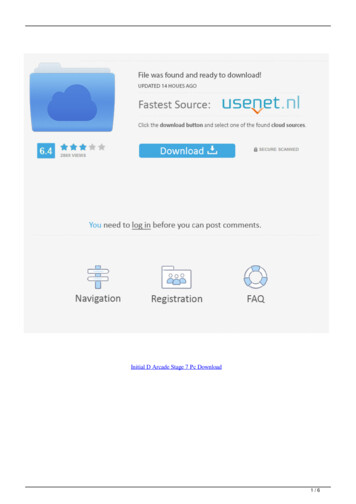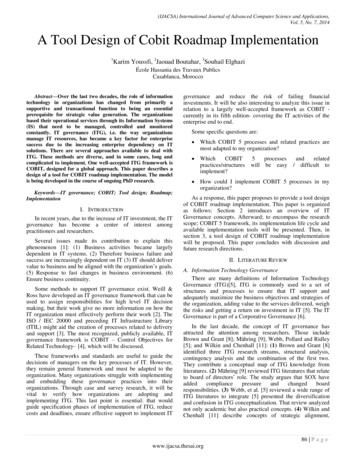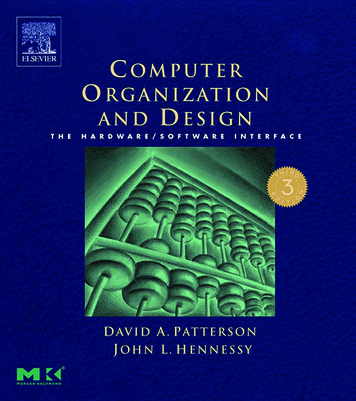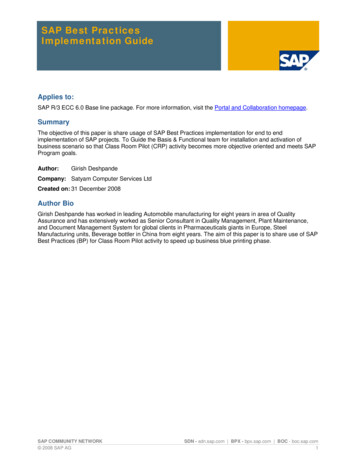
Transcription
Design and Initial Implementationof a Distributed XML DatabaseFrancesco PagnamentaA dissertation submitted to the University of Dublin,in partial fulfilment of the requirements for the degree ofMaster of Science in Computer ScienceSeptember 2005
DeclarationI declare that the work described in this dissertation is, except where otherwisestated, entirely my own work and has not been submitted as an exercise for a degreeat this or any other university.Francesco PagnamentaDated: September 9, 2005
Permission to Lend and/or CopyI agree that Trinity College Library may lend or copy this dissertation upon request.Francesco PagnamentaDated: September 9, 2005
AcknowledgementsI would like to thank my supervisor Declan O’Sullivan for his guidance throughoutthis project. Thanks also to Ruaidhri Power of the Knowledge and Data EngineeringGroup (KDEG) for his help.Special thanks to my family and friends, and to the Balzli family for their supporthere in Dublin.Finally, I would like to thank the NDS class for an enjoyable year.Francesco PagnamentaUniversity of DublinSeptember 2005iv
AbstractTechniques for distributed relational database systems have been well researchedand developed. This is unsurprising given that the relational database model itselfhas been in development since the early 1970s. In recent years, XML has emergedas an excellent simple format for structuring and exchanging data, and the problem of using relational databases or specially designed ”native” XML databases formanaging XML data has also been gradually addressed. However, although someresearch has gone into providing techniques for different parts of the distributedXML database problem, very little research has gone into trying to put these techniques together in order to create a distributed XML database platform.This project investigates the design issues that need to be addressed for the implementation of such a distributed XML database platform. It surveys the state-ofthe-art of XML-based technologies that can be adopted and mechanisms that canbe used.The dissertation proposes a layered architecture with a data access infrastructureat the bottom layer able to integrate different types of databases supporting XML.Acting on the top of the access infrastructure, three main functional componentsare proposed: a distributed transaction manager, a distributed query processor, anda distributed schema manager. Additionally, support for distributed transactionshas been designed and implemented.The project includes an initial implementation of the system. The evaluation ofthe implementation shows that an XML-based multidatabase system is conceivable.However, it emerged that some techniques required for achieving an efficient XMLdistributed database have to be enhanced.v
ContentsAcknowledgementsivAbstractvList of FiguresixList of TablesxChapter 1 Introduction1Chapter 2 Background and State-of-the-Art62.1The eXtensible Markup Language (XML) on Databases . . . . . . . .2.2XML Databases . . . . . . . . . . . . . . . . . . . . . . . . . . . . . . 102.362.2.1Moving Toward XML Databases . . . . . . . . . . . . . . . . . 112.2.2Transaction Processing on XML Data . . . . . . . . . . . . . . 132.2.3XML Distributed Databases . . . . . . . . . . . . . . . . . . . 14Distributed Transaction Processing . . . . . . . . . . . . . . . . . . . 172.3.1Implementing Distributed Transactions . . . . . . . . . . . . . 172.3.2X/Open Distributed Transaction Processing (DTP) Model . . 202.3.3Examples of Distributed Transaction Technologies . . . . . . . 21Chapter 3 Design233.1Vision . . . . . . . . . . . . . . . . . . . . . . . . . . . . . . . . . . . 233.2System Overview . . . . . . . . . . . . . . . . . . . . . . . . . . . . . 243.3Requirements Analysis . . . . . . . . . . . . . . . . . . . . . . . . . . 253.3.1System Requirements . . . . . . . . . . . . . . . . . . . . . . . 26vi
3.3.2Infrastructure Requirements . . . . . . . . . . . . . . . . . . . 293.4System Architecture Revisited . . . . . . . . . . . . . . . . . . . . . . 303.5Design of the Platform Components . . . . . . . . . . . . . . . . . . . 303.5.1Connectivity Layer . . . . . . . . . . . . . . . . . . . . . . . . 313.5.2Distributed Query Processor . . . . . . . . . . . . . . . . . . . 353.5.3Distributed Transaction Manager . . . . . . . . . . . . . . . . 393.5.4Distributed Schema Manager . . . . . . . . . . . . . . . . . . 423.5.5Client Access Layer . . . . . . . . . . . . . . . . . . . . . . . . 443.6Interaction between DTM and DQP . . . . . . . . . . . . . . . . . . . 443.7Design Issues . . . . . . . . . . . . . . . . . . . . . . . . . . . . . . . 47Chapter 4 Implementation484.1Implementation Overview . . . . . . . . . . . . . . . . . . . . . . . . 484.2Databases . . . . . . . . . . . . . . . . . . . . . . . . . . . . . . . . . 484.3Libraries . . . . . . . . . . . . . . . . . . . . . . . . . . . . . . . . . . 514.4XDDBMP . . . . . . . . . . . . . . . . . . . . . . . . . . . . . . . . . 524.54.4.1Oracle and XML-RPC Client Side Connectivity . . . . . . . . 524.4.2Distributed Query Processor . . . . . . . . . . . . . . . . . . . 53XDBME . . . . . . . . . . . . . . . . . . . . . . . . . . . . . . . . . . 564.5.1XML-RPC Server Side Connectivity . . . . . . . . . . . . . . 564.5.2SleepyCat Binding . . . . . . . . . . . . . . . . . . . . . . . . 574.6Platform utilities . . . . . . . . . . . . . . . . . . . . . . . . . . . . . 574.7Implementation Issues . . . . . . . . . . . . . . . . . . . . . . . . . . 59Chapter 5 Evaluation605.1Benchmarking XML Databases . . . . . . . . . . . . . . . . . . . . . 605.2Experiments Overview . . . . . . . . . . . . . . . . . . . . . . . . . . 615.3Global Evaluation . . . . . . . . . . . . . . . . . . . . . . . . . . . . . 615.4Transaction scheduler comparison . . . . . . . . . . . . . . . . . . . . 655.5General Discussion . . . . . . . . . . . . . . . . . . . . . . . . . . . . 68vii
Chapter 6 Future Work and Conclusions696.1Future Work . . . . . . . . . . . . . . . . . . . . . . . . . . . . . . . . 696.2Conclusions . . . . . . . . . . . . . . . . . . . . . . . . . . . . . . . . 70Bibliography74Appendix A SimpleXQueryX Example79Appendix B Query Processing81B.1 Oracle Query Translator . . . . . . . . . . . . . . . . . . . . . . . . . 81B.2 SleepyCat Query Translator . . . . . . . . . . . . . . . . . . . . . . . 82Appendix C Transaction scheduler84Appendix D XML Documents87viii
List of Figures1.1Vision of the system. . . . . . . . . . . . . . . . . . . . . . . . . . . .42.1Global schema view of a multi-database system. . . . . . . . . . . . . 152.2DTP model. . . . . . . . . . . . . . . . . . . . . . . . . . . . . . . . . 213.1Overview of the platform. . . . . . . . . . . . . . . . . . . . . . . . . 243.2Architecture of the platform. . . . . . . . . . . . . . . . . . . . . . . . 253.3Architecture of the platform revisited.3.4XAResource interface on the platform. . . . . . . . . . . . . . . . . . 333.5Connectivity layer interfaces. . . . . . . . . . . . . . . . . . . . . . . . 343.6A layered view of the platform. . . . . . . . . . . . . . . . . . . . . . 353.7Query fragmentation and mapping. . . . . . . . . . . . . . . . . . . . 383.8Database content scenario. . . . . . . . . . . . . . . . . . . . . . . . . 403.9Case study - a transaction execution. . . . . . . . . . . . . . . . . . . 41. . . . . . . . . . . . . . . . . 313.10 Distributed schema manager architecture. . . . . . . . . . . . . . . . 433.11 Class diagram of the platform’s core. . . . . . . . . . . . . . . . . . . 453.12 Sequence diagram of a transaction execution. . . . . . . . . . . . . . . 464.1Implementation overview. . . . . . . . . . . . . . . . . . . . . . . . . 495.1Documents stored on the databases for the evaluation. . . . . . . . . 625.2Response time comparison. . . . . . . . . . . . . . . . . . . . . . . . . 645.3Response time for each schedulers. . . . . . . . . . . . . . . . . . . . 67C.1 Scheduler class diagram. . . . . . . . . . . . . . . . . . . . . . . . . . 85ix
List of Tables3.1Database Requirements . . . . . . . . . . . . . . . . . . . . . . . . . . 303.2Case study: a trasaction definition . . . . . . . . . . . . . . . . . . . 404.1Surveyed databases . . . . . . . . . . . . . . . . . . . . . . . . . . . . 494.2Implemented data manipulation operations . . . . . . . . . . . . . . . 545.1Global Evaluation Transactions . . . . . . . . . . . . . . . . . . . . . 635.2Transaction definition for the schedulers comparison . . . . . . . . . . 66x
Chapter 1IntroductionThe eXtensible Markup Language (XML) [1] is a data model language for documents which was created to structure, store and send information. It was originallydesigned to deal with large-scale electronic publishing, but it has become a populartext format for data exchange across the Web and other networks.Considering that it became a WWW Consortium (W3C) [2] recommendation in1998, a surprising number of software vendors have adopted this standard and itssuccess appears to continuously grow. In fact, it has been widely adopted for a widerange of applications such as health-care, manufacturing, financial services, government and publishing sectors. XML and XML based standards such as Web Servicesseems to emerge as the de-facto mechanism for exchanging structured informationbetween organizations and more generally applications.Because of its success, there is the increasing need to store XML data as it is,in order to skip the data conversion process required to use traditional databases.Nowadays, many popular XML-enabled databases1 provide the ability of storing andretrieving XML data through a data format converter. Alternatively, some databaseproducts and open-source initiatives are designed to accommodate data in a native1Database Management Systems that do not use a hierarchical data model but they are extendedwith some sort of data model converter (e.g. Relational DB with an XML connector)1
format (native XML databases2 ). Although the research in this area is in the earlystages, XML native database systems are making their appearance into the worldof academia and the IT market.MotivationOracle, one of the major vendors of databases, claims on its website that ”in the fastmoving world of IT technology, the W3Cs XML standards rank second in terms ofpopularity behind ANSI/ISOs SQL standard”. Nowadays, relational databases areconsidered the most deployed repository systems, but it is not excluded that in thefuture XML-native databases will be more popular. It is true that the research inthis area is picking up producing a number of studies investigating various aspectof this data format and related technologies, from the lowest levels (e.g. concurrentaccess to XML documents) to the higher ones (e.g. involving Web Services [3]).The emergence of technologies designed to operate in a distributed environmentand relying on W3Cs recommendations has pushed the research community to studythe distribution of XML data. However, because basic concepts are not fully available, not much research has been carried out considering a distributed environment.The motivation behind this project is linked to the current state of this novelresearch field in which many mechanisms have not been studied in detail and/orcommonly recognised. In particular, apart to some extent for technologies orientedtoward Web Services, it has not been found any relevant work describing the issuesthat have to be addressed to distribute XML repositories. Those research topicsinclude distributed transaction processing, query processing and global schema onXML-oriented multi-database systems.2Apart from being a marketing term, it has never had a formal technical definition [20]. Anative XML database can be considered a database designed following a hierarchical data modeland typically accessible with XML-based data manipulation languages.2
GoalsThis project aims to investigate several aspects related to the distribution of XMLdocuments on data sources. Particular emphasis is put on distributed transactionprocessing. Related aspects such as query processing and global schema representations are also considered.The project is application oriented since it aims to design an XML-based distributed database system. The first phase of the project produces a state-of-the-artof the research area surveying technologies that are involved. Then, a platformis designed developing the concept illustrated in Figure 1.1. The platform featuresthree main components: a distributed transaction manager, a distributed query processor, and global schema manager. Those components reside on top of a softwareinfrastructure providing location transparency to the remote databases on whichdata is physically stored. In the example, the platform integrates three databasemanagement systems of which two of them uses a different data models other thanXML (relational and object), but they both hold a data model converter.Provided the global schema, a client application can therefore query/modify theplatform’s data as if it was a local database. Global data consistency is guaranteedby distributed transactions, while location transparency is provided by mechanismsimplemented in the distributed query processor.Additionally, the project’s objective include a partial implementation of the platform permitting a more concrete investigation of the studied methods as well as anevaluation of the adopted techniques.ContributionsThe main contributions of this work can be summarised as follows: Design of an XML-based multi-database system describing how a transactionmanager, a query processor, and a schema manager can cooperate to providethe services required by external applications.3
Figure 1.1: Vision of the system. A partial implementation of the platform featuring a transaction processorand a basic query processor. The platform accesses two database productsusing different access methods. The implementation of a simple connectivity supporting distributed transactions. Hence, a database management system (not supporting distributedtransactions) is integrated into the platform using the developed client/servercommunication system as well as a distributed transaction module operatingon the top of the repository. An evaluation of the implemented platform indicating that an XML multidatabase system is conceivable.4
Dissertation OutlineChapter 2 introduces the research field and presents the recent advances that havebeen achieved in recent years. It also briefly reports an overview of techniques usedfor previous databases that can be re-used in an XML environment. A number oftechnologies and systems are also presented.The design of the platform is reported in Chapter 3. It is initially presented themain architecture of the system with its major components. Every component isthan described in the subsequent sections.Chapter 4 explains what of the platform designed in Chapter 3 has been actuallyimplemented. Chapter 5 contains two experiments for evaluating the implementedsystem. Chapter 6 lists future work in this area and draw conclusions.5
Chapter 2Background and State-of-the-ArtThis chapter reports some fundamentals of XML database systems as well as thestate-of-the-art techniques related to this new technology. As already mentionedearlier in this report, the research on XML databases is in the early stages. Onlyrecently the scientific community has started to investigate this field, usually takingadvantage of previous well-studied database technologies to use as a base to advancenovel mechanisms applicable to this area.2.1The eXtensible Markup Language (XML) onDatabasesXML appeared in the late nineties following several similar formats having sameprinciples and purposes. Although it became rapidly popular among the scientificand commercial communities, XML is not a revolutionary idea; it was even not anew idea at that time. It came along with the boom of the Web and its applications.XML was introduced as a standard at the right time by an independent body, theWWW Consortium (W3C). Its predominant employment as a data exchange formaton the Internet and elsewhere pushed the development of XML data repositories.6
XML data definition languagesDocument Type Definition (DTD) [4] defines a document structure with a list oflegal elements. Although its simplicity, it lacks of important features required by theincreasing number of applications that rely on the XML standards. For instance,DTD does not include a direct way to define types (e.g. integer, string, etc.). Inorder to overcome this and other limitations, in 2001 the W3C approved a newdefinition language named XML Schema [5]. XML Schemas provide a powerfulmean for defining the structure, content and semantics of documents. The syntax,unlike DTDs, is expressed in XML allowing, theoretically, XML Schemas to beprocessed as their instances.Structured, Semistructured, and Unstructured DataThe information stored in a database is known as structured data because it has toobey strict definition rules. Typically, when defining tables on a relational database,for each column, it has to be rigorously defined the type and, if required, its constraints. However, some applications may require a more relaxed approach wherenew data items can be added at any time. This type of data is described as semistructured (sometimes also referred as self-describing data). A key difference betweenstructured and semistructured data is how schema constraints are defined and applied: structured data complies with schema directives whereas in semistructureddata the information that is normally associated with a schema is contained withinthe data. Finally, a third category, known as unstructured data, has very limitedindications of the type of data (e.g. an HTML page).From a database perspective, one of the key decisions to be made is either to usea structured or an unstructured storage. XML-enabled and XML-native databasesoften provide the ability to store both categories. For a company, it might be necessary to simply store an entire document, no matter what its structure is. Incontrast, applications might need to validate data against a schema before storingit. On Tamino XML Server [6] documents can be stored in collections residing on7
databases. Both documents and collections are defined through XML Schema annotations. Whenever inserting or modifying data, the operation can be performedonly if it is in accord with the schema constraints.The semantics expressed by schemas can also be used for optimisation purposes.Semantic query optimisation relies on constraints defined on the database schemato modify a query into another query that is more efficient to execute (query rewriting). [24] explains how to achieve a higher degree of concurrency when performingtransactions by exploiting the semantics expressed in DTDs.XML ProcessingA software module called an XML processor is used to read XML documents andprovide access capabilities to their content and structure. An XML processor istypically operating on behalf of another software module which provides servicesto external entities. The specification of an XML processor describes its behaviourin terms of how it reads XML data and which kind of information it provides tothe application. The two dominant specifications for handling XML documents arethe Document Object Model (DOM) [7] and the Simple API for XML (SAX) [8].DOM, which is a W3C standard, provides an object tree-based representation of thedocument; whereas SAX, a de facto standard, provides an application interface thatexploits events occurring on a XML data stream model (e.g. open tag, closed tag,end of the document, etc.). The two processors are chosen according to the application requirements. SAX is more indicated to pass through a document in read-onlymode. In contrast, DOM features read and update functionalities but it is knownto be quite slow because of the system resources it needs. Since both specificationsare designed to be platform- and language-independent, they are included in mostprogramming languages.The Extensible Stylesheet Language Family (XSL) [9] is a set of recommendationsfor defining XML document transformations and presentations. It embodies a language for transforming XML (XSL Transformations, XSLT), an expression languageused by XSLT to access or refer to parts of an XML document (the XML Path8
Language, XPath [10]), and a language for formatting information for paginatedpresentations (XSL Formatting Objects, XSL-FO). As for XML Schemas, XSL isexpressed through an XML syntax.A weakness of XML processing involves its performance impact on systems, principally because its operations are processing intensive. Parsing is therefore consideredone of the major barriers for the development of high-performance XML-based technologies including XML databases [26] in which, as for any database, high-speed dataaccess is a crucial concern.XML data manipulationIn [30] a group of researchers in the field reports the experience in designing andimplementing XML query languages. It emerged that two communities are contributing to the development of such language: the database community which ismore concerned about the requirements of large repositories, and the documentcommunity which put more emphasis on integration and full-text search on singledocuments. This scenario may suggest the difficulties the W3C have to face to eventually come up with a solution that optimally satisfy both communities.XL [11] is a language produced by the document community. It is quite similar tothe W3C’s XPath. The XML-QL [12] language introduced by the W3C was anothersolution providing data manipulation capabilities.More recently, the W3C XQuery [13] standard integrates the features of previous languages and currently, looking at the features of XML-native or -enabled databases,it seems to be a good solution (at least for querying data). XQuery relies on theXPath language to access part of an XML document.An XQuery feature to mention is the ability of construct query results by materialising XML data with a high level of flexibility. This is achieved with the FLWORexpression principle (pronounced ’flower’ standing for For, Let, Where, Order by,Return) that supports iteration and binding of variables to intermediate results.The W3C has defined the XQuery Update Facility Requirements in order to makeXQuery a full data manipulation language, just like SQL for relational databases.But the fact remains that, at this stage, there is not a commonly agreed language9
or language extension to update XML documents. Quite a lot of works have beencarried out either to extend existing access languages or to propose new ones.The XML:DB Initiative [14] aims to develop technology specifications for managing data on XML Databases. In the XML:DB framework, the XUpdate Project isintended to specify an Update Language for XML Documents via an XML syntax,the goal of the XML Database API Project is to develop an unique programminginterface for XML Databases, and, finally, a working group has designed a commonsyntax and semantic for performing tasks on XML repositories (the Simple XMLManipulation Language).Few open-source databases have adopted the technologies proposed by the XML:DB(e.g. eXist [15] and Apache Xindice [16]) initiative but it appears the commercialdatabase vendors tend to use a proprietary language while waiting for W3C standards. Oracle XML DB [17] includes an SQL-like extension for access and updateXML documents. The recent release 10 also fully supports XQuery. A DBMS mayalso provide other kind data manipulation such as DOM and XSL. Oracle XML DBprovides a DOM access interface to manipulate XML data stored on the database.2.2XML DatabasesA database is a collection of shared data. A Database Management System (DBMS)is a software that allows databases to be defined (e.g. data types, structures, constraints, etc.), constructed (i.e. populating the database), and manipulated (i.e.querying and updating data) [47]. In few words, a DBMS provides all tools necessary for managing a database.A data model is the level of abstraction that hides low-level mechanisms controllingthe native data representation over the physical storage. Data definition and manipulation is then performed via high-level operation applied on the data model. Avery common conceptual data model is the relational one which organises data intables and relations among items contained in tables. A data definition language(DDL) is expressed via a syntax suitable to represent the data model. A data ma10
nipulation language (DML) consists of two operation sets; data querying and dataupdating. In relational databases the structured query language (SQL) is used toboth query and update a database. As already mentioned previously, up to now, thehierarchical data model does not dispose of a standard data manipulation languagethat integrates querying and updating facilities.2.2.1Moving Toward XML DatabasesRecent advancements in the development of XML native databases management systems [20] such as Tamino [31] or Timber [32] confirms the trend: XML documentswill not only be exchanged, but they will also be stored. In addition to the entrance of such databases in the world market, most of the commercial XML-enableddatabases include converters. Because of this, users may be unlikely to abandontechnologies that have been studied for a long time in the past and, as it is the caseof the relational database technology, they are based on strong theoretical basis.The difference between XML-native and XML-enabled may be quite vague, especially because it is believed that the term native XML databases was introducedfor marketing reasons [20]. In any case, XML-enabled databases can be consideredrepositories that were not initially designed to store data in a hierarchical manner,but they provide an additional data format converter in order to support the XMLstandard and related technologies. [20] reports a possible definition of a native XMLdatabase based on the following three concepts: it defines a (logical) model for an XML document, and stores and retrievesdocuments according to that model. it has an XML document as its fundamental unit of (logical) storage, just asa relational database has a row in a table as its fundamental unit of (logical)storage, and it is not required to have any particular underlying physical storage model.11
Several vendors of native XML databases claim their product support transactions (and presumably support rollbacks). However, locking is often at the level ofentire documents, rather than at the level of individual nodes, so multi-user concurrency can be relatively low.The research community is carrying out a noticeable effort to investigate efficient and reliable ways to publishing relational data as XML and vice-versa [33][34]. Despite the achievements, in some cases, mapping the model is not enough.For example, running a transaction virtually following a hierarchical data model butactually on a relational database having locking mechanisms designed for relationaldatabases might cause locks to be applied with an unnecessary granularity, leadingto performance degradation. This example is known in the literature as pseudoconflict that results in low inter-transaction parallelism [23].Surveys have shown that data represented in XML and stored in a text file isthree times the size of data in Java objects or in relational tables [40]. Adding tothis the fact that the use of XML generates higher overhead comparing to other representations, XML itself is not the best data representation for databases. Hence,database developers have to devise techniques that make the XML data representation more adapted for this purpose. Other than reducing the disk space required,various optimisations should be applied including memory management, XML parsing optimisations, node searching optimisations, and type conversion [40].To improve data access, xml databases support the creation of indices on storeddata. Indices, just as other DBMS, can be used to improve the speed of queryexecution. The details of what can be indexed and how indices are applied willvary widely between products, but most support the feature in some form. Anotherfeature required for some applications is the ability of DBMSs reacting when someevents occur (active databases). A number of DBMS includes some form of triggerin their products; so does Tamino XML server.12
2.2.2Transaction Processing on XML DataTransactions are a key concept to guarantee reliability of information systems anddata consistency in the presence of system failures and interleaved access to shareddata. They must be carried out so that their effect on data is serially equivalent.In order to support transactions, a DBMS has to implement a series of mechanismsthat may depend on the storage model adopted on the database.Storage and locking mechanismsAt present, there are essentially three possibilities of storing XML documents [24].The simplest option and, from the performance point of view, also the worst, is touse an ordinary file system. In this scenario, locks are applied to entire documentscausing poor concurrent access. The second alternative is to rely on an existingobject or relational database. In the case of relational database systems, there aredifferent translation mechanisms. Even if the translation technique is well engineered, it is not always the same for concurrent access since different document mayshare tables resulting in a too restrictive locking mechanism. The only translationscheme, in which tables are not shared, stores XML documents in Character LargeOBjects (CLOBS). But again, locking is applied at the document level.The third option is to adopt or implement an XML base management system(XBMS). In brief, it is possible to re-use we
A partial implementation of the platform featuring a transaction processor and a basic query processor. The platform accesses two database products using different access methods. The implementation of a simple connectivity supporting distributed trans-actions. Hence, a database management system (not supporting distributed
